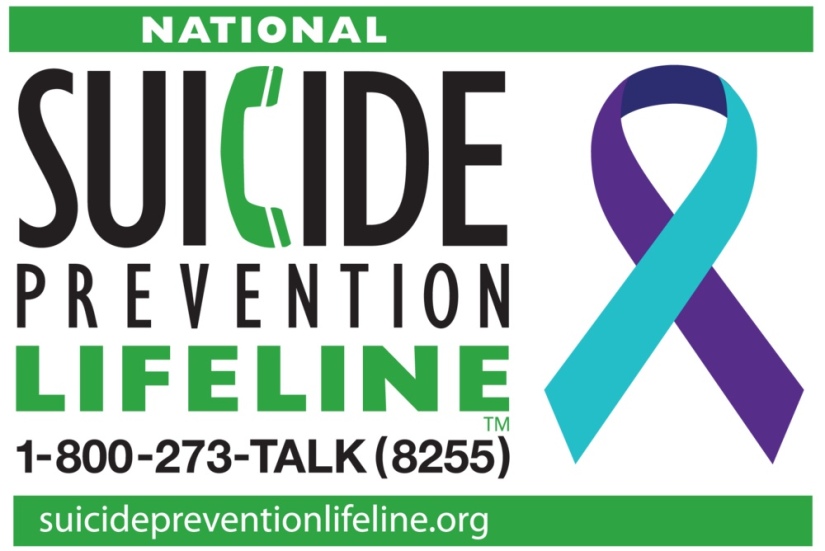
September is National Suicide Awareness Month and September 9-15 is National Suicide Awareness Week. We will get back to the psychosis disorders soon, but this week we are going to talk about suicide. *Please be aware this may be sensitive content and can be a trigger for some individuals. Discretion is advised.*
Suicide
Suicide is the act of taking one’s own life. This can be violent or non-violent. A suicide attempt is when people harm themselves with the intent to kill themselves but do not die as a result of these actions. Suicide is the 10th leading cause of death in the United States (2% of total population). Men are more likely to be successful with suicide and typically use more violent means whereas women attempt suicide more often with less violent means. Violent means include guns, knives (stabbings) and hanging. Non-violent means include overdoses, drownings and knives or razors (wrist slitting).
Risk factors can vary from ages to ethnicities. Some of the most common risk factors include: depression and other mental disorders, substance use, prior suicide attempts, family history, family or relationship violence, or incarceration. American Indian and Alaskan Native youth have a higher risk. LGBTQ teens also have a higher risk. Some signs, symptoms and wording you may hear a person at risk say vary as well. They include: talking about wanting to die or kill themselves, making a plan, talking about feelings of hopelessness, stating they have no reason to live, talking about being a burden, feeling trapped, or being in unbearable pain (may be physical), increase in substance use, anxiety, agitation, reckless behavior, sleeping too much or too little, withdrawal, rage, extreme mood swings, saying goodbye to family and friends, making a will, and giving away possessions they love.
If you have a suspicion that someone is having a crises and may hurt themselves you need to ask the following questions:
- Are you having suicidal thoughts?
- Are you thinking about killing yourself?
If the answer is yes to the previous questions or you’re still unsure ask these questions next:
- Do you have a plan on how you will kill yourself?
- Have you decided on when you would kill yourself?
- Have you taken any actions to secure the objects you need to carry out your plan of suicide?
Never leave these patients alone. Ask them if they would like to go to the hospital or to a doctor that they are comfortable with. When in doubt always call 911. Stay open and non-judgemental when talking. Always express empathy. They are not seeking attention in an unnecessary way. These people often times are looking for someone to just listen. Suicide is not about hurting oneself but the release of the pain and suffering they are experiencing.
Treatments for suicide often involve treatment of the underlying mental health disorder. Medications and cognitive therapy will be used. Sometimes though, acute hospitalization and mental health facilities are required. In the hospital I work at patients are monitored for a minimum of 24 hours if they answer yes to feeling like they are going to harm themselves. We observe them, a psychologist will come see them and they have what we call a safety sitter. Safety sitters are with the patient 24/7 to make sure they do not harm themselves. Everything is removed from the patient’s room and they have to wear paper scrubs. If patients are brought in by the police they will be what we called a 302. It is an involuntary commitment. The patient cannot leave for at least 72 hours and have to be cleared by the provider. The magistrate also gets involved and need to know when the patient is released. There is also a 201 which is a voluntary commitment. These patients know they are having a crises and are seeking help. They also have to stay for 72 hours but can leave with a 24 hours notice to the provider. If the patient seems like a danger to themselves or others though they can be changed to a 302. Sometimes, a patient cannot receive all the help they need in an acute care setting so they go to a psychiatric hospital for more long term regulation of their medications and more intense therapy than what a hospital can provide.
Some providers refer to suicidal patients as being actively suicidal and passively suicidal. Active refers to having a plan and intending to go through with that plan. Passive is when you do not have a plan but you would not stop anything happening to you. There are blurred lines sometimes with passive being used to refer to self harm as well.
Non-Suicidal Self Injury
There are a few names non-suicidal self injury is referred to as; this includes self harm, self mutilation, and parasuicide. This is injury that has no intention of ending in suicide. Sometimes it is quite difficult to tell the difference between self harm and a suicide attempt. There are many different types of self harm;
- cutting, scratching, or pinching skin enough to bleed or to leave a mark on the skin
- banging or punching objects to the point of bruising or bleeding
- ripping or tearing the skin
- carving words or patterns into the skin
- interfering with the healing of wounds
- burning the skin with cigarettes, matches, or hot water
- pulling out hair
- deliberate overdose on medications without intention of suicide
- sudden excessive tattooing or piercings
The main thing to understand about self harm is that it is a coping mechanism. It is helping make the mental pain they feel more physical, which in the mind of most people is more acceptable. It may be more harmful to try to get a person to stop self harm. Try to address the problem that is causing the self harm. Conversations have to be direct. 911 is always appropriate for these situations.
Personally, I have had a family member be actively suicidal and I have been passively suicidal. I had been awake for five days (eventually diagnosed as a manic episode). I came home from work and was finally so tired I decided to take my prescribed xanax. However, I did not take the prescribed dose of 0.25mg. I took 0.75mg, ran a warm bath, lit a candle and tried to relax. After an hour, I was still awake. So this time I took 75mg of benadryl. This is also three times the dose but I have an autoimmune disorder that prevents me from taking small doses of benadryl (so technically this was my prescribed dose). I assume I fell asleep because I remember waking up about 2-3 hours later with my dog licking my face, cold water and coughing from inhaling water. This should have ended otherwise but I am quite thankful that my puppy somehow got through a locked door. This is why he is now spoiled to high heavens. I have also carved things into my skin and I pick at my skin until it bleeds. This is all anxiety driven.
People are extremely judgemental about suicide. They find it to be selfish. They say that suicidal people are only thinking about themselves and not their loved ones. But the thing is that they are thinking about themselves, as they should be. They are so tired and fed up of all the pain and suffering that they feel like the only way out is to be dead. They are NOT doing it to hurt the people they love. They are just trying to solve their problems.
Thanks again for reading. If you have any questions or just want to talk I am always here! Below are my resources and good places to find more information!
nimh.nih.gov
mentalhealthfirstaid.org
National Suicide Hotline (free and confidential)
- 1-800-273-TALK (8255)
- Text “Connect” to 741-741
- http://www.suicidepreventionlifeline.org
Spanish National Suicide Hotline
- 1-800-628-9454
Poison Control Center
- 1-800-848-6946
Suicide Prevention Resource Center
Veterans Crisis Line
- 1-800-273-8255
- Press 1
The Trevor Project
- http://www.thetrevorproject.org
- 1-866-488-7386
To Write Love On Her Arms
